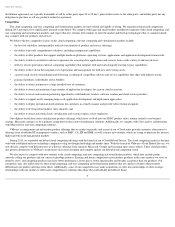VMware 2013 Annual Report Download - page 21
Download and view the complete annual report
Please find page 21 of the 2013 VMware annual report below. You can navigate through the pages in the report by either clicking on the pages listed below, or by using the keyword search tool below to find specific information within the annual report.
Table of Contents
delivery of upgrades and enhancements to our existing products and services. The market for expert software developers upon whom we rely has become
increasingly competitive. We generally do not have employment or non-compete agreements with our existing management or development personnel, and,
therefore, they could terminate their employment with us at any time without penalty and could pursue employment opportunities with any of our
competitors. Changes to management and key employees can also lead to additional unplanned losses of key employees. The loss of key employees could
seriously harm our ability to release new products and services on a timely basis and could significantly help our competitors.
Because competition for our target employees is intense, we may not be able to attract and retain the highly skilled employees we need to support our
planned growth, and our compensation expenses may increase.
To execute on our strategy, we must continue to attract and retain highly qualified personnel. Competition for these personnel is intense, especially for
senior sales executives and engineers with high levels of experience in designing and developing software. We may not be successful in attracting and
retaining qualified personnel. We have from time to time in the past experienced, and we expect to continue to experience in the future, difficulty in hiring
and retaining highly skilled employees with appropriate qualifications. Many of the companies with which we compete for experienced personnel have
greater resources than we have. Research and development personnel are also aggressively recruited by startup and emerging growth companies, which are
especially active in many of the technical areas and geographic regions in which we conduct product and service development. In addition, in making
employment decisions, particularly in the high-technology industry, job candidates often consider the value of the stock-based compensation they are to
receive in connection with their employment. Declines in the value of our stock could adversely affect our ability to attract or retain key employees and result
in increased employee compensation expenses. If we fail to attract new personnel or fail to retain and motivate our current personnel, our business and future
growth prospects could be severely harmed.
Our success depends upon our ability to develop new products and services, integrate acquired products and services and enhance our existing products
and services and develop appropriate business and pricing models.
If we are unable to develop new products and services, integrate acquired products and services, enhance and improve our products and support services
in a timely manner, or position or price our products and services to meet market demand, customers may not buy new software licenses from us, update to
new versions of our software or renew product support. In addition, information technology standards from both consortia and formal standards-setting
forums as well as de facto marketplace standards are rapidly evolving. We cannot provide any assurance that the standards on which we choose to develop
new products and services will allow us to compete effectively for business opportunities in emerging areas such as cloud computing.
New product and service development and introduction involves a significant commitment of time and resources and is subject to a number of risks and
challenges including:
In addition, if we cannot adapt our business models to keep pace with industry trends, our revenues could be negatively impacted. For example, if we
increase our adoption of subscription-based pricing models for our products, we may fail to set pricing at levels appropriate to maintain our revenue streams
or our customers may choose to deploy products from our competitors that they believe are priced more favorably. Additionally, we may fail to accurately
predict subscription renewal rates or their impact on results of operations, and because revenue from subscriptions is recognized for our services over the
19
• managing the length of the development cycle for new products and services and product and service enhancements, which has frequently been
longer than we originally expected;
• increasing complexity of our product offerings as we introduce product suites such as our vCloud Suite, which can significantly increase the
development time and effort necessary to achieve the interoperability of product suite components while maintaining product quality;
• managing customers’
transitions to new products and services, which can result in delays in their purchasing decisions;
•
adapting to emerging and evolving industry standards and to technological developments by our competitors and customers;
•
entering into new or unproven markets with which we have limited experience;
•
reacting to trends and predicting which technologies will be successful and develop into industry standards;
•
tailoring our business and pricing models appropriately as we enter new markets and respond to competitive pressures and technological changes;
•
incorporating and integrating acquired products and technologies; and
•
developing or expanding efficient sales channels.
























